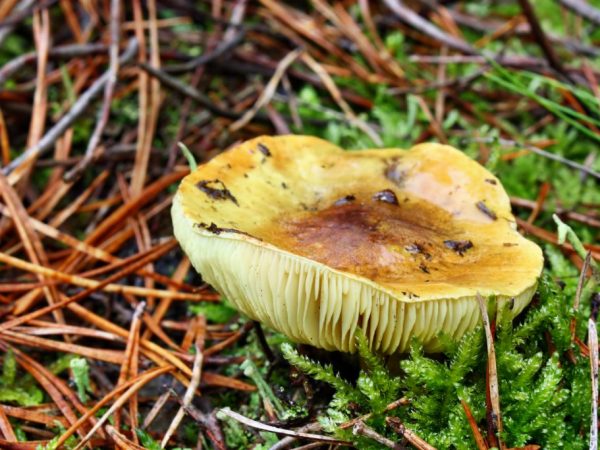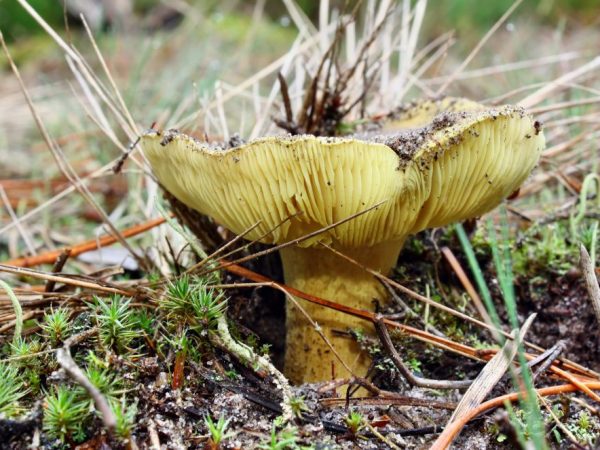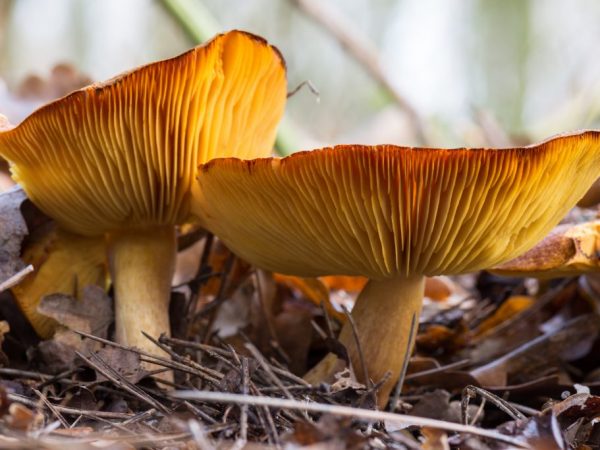Description of green mushroom
The conditionally edible greenfinch mushroom, or green ryadovka, was named because of its specific color, which remains even after heat treatment. Greenfinch mushrooms are autumn representatives of the mushroom community. They grow in pine, deciduous and mixed forests on sandy soils.

Description of green mushroom
Description of the mushroom
Zelenushka, or ryadovka green, in an adult state has a hat that reaches a diameter of 5 to 15 cm and has a bulge in the central part. In terms of structure, the upper part, i.e. the cap is dense and rather fleshy; with age, scaly appears on it. In the center, the scales are small. The cover tissue is thickened, smooth to the touch, becomes especially slimy and sticky in wet weather. Particles of soil and grains of sand often adhere to the skin.
The color of the cap varies within the yellow-green spectrum, becoming yellow-greenish or olive-yellowish, with aging the color darkens. On the lower surface of the cap, very thin plates with a width of 4 to 13 mm are densely located.
The pulp is compacted in structure, white, gradually acquiring a yellowish tint. On the cut, the color of the pulp does not change under the influence of air. It is characterized by a fresh flour or cucumber aroma, which becomes richer when located next to conifers.
Greenfinch mushroom does not have a distinct taste. It is rarely affected by worms and parasites. The yellow-greenish leg is shortened, its height is usually 2.5-9 cm, and its diameter is up to 2.5 cm. It has a cylindrical shape, noticeably thickens towards the base and is covered in its lower part with brownish scales. Ordinary green ryadovka has a white spore powder.
Irina Selyutina (Biologist):
Greenfinch mushroom, aka green ryadovka, is a mycorrhizal-forming organism that forms a fungus root with representatives of coniferous trees. They are more often found in conifers, less often in deciduous forests. Since they grow on sandy soils, they must be thoroughly washed out of sand particles. On sandy soils next to the greenfinch, a gray row can also bear fruit, which differs from the greenfinch in the color of the cap and leg. Since, since 2001, cases of poisoning with this mushroom have become public, these conditionally edible mushrooms have become "suspected" of poisonousness. Studies have shown that they contain toxins that can damage the heart and skeletal muscles, as well as the kidneys.
Grows on sandy and sandy loam soils.
The description of the greenfinch mushroom is often confused with other representatives of the Tricholoma genus (Ryadovka):
- sultry ryadovka: inedible look;
- R. sulfuric: slightly poisonous species;
- R. isolated: conditionally edible species.
Composition
The saturated chemical composition of the mushroom testifies to its beneficial properties and includes, per 100 g of pulp: 3.27 g of carbohydrates, 3.08 g of proteins, 0.35 g of fat, 92.43 g of water and 0.84 g of inorganic substances.
Greenfinch contains a complex of vitamins necessary to maintain the vital functions of the body, among them:
- pyridoxine,
- cyanocobalamin,
- betaine,
- vitamin C,
- calciferol,
- ergocalciferol,
- thiamine,
- riboflavin,
- pantothenic acid,
- folic acid,
- choline,
- alpha-tocopherol,
- beta-tocopherol,
- gamma-tocopherol,
- delta-tocopherol,
- alpha-tocotrienol,
- dihydrophilloquinone,
- a nicotinic acid.

Greenfinch contains many useful substances
The chemical composition of the green row also includes a number of amino acids:
- aspartic acid,
- arginine,
- valine,
- histidine,
- tryptophan,
- threonine,
- isoleucine,
- lysine,
- methionine,
- alanine,
- glutamic acid
- glycine,
- proline,
- serine,
- cystine,
- phenylalanine.
The easily digestible carbohydrates that make up the mushroom include glucose and fructose. Fiber is responsible for stabilizing blood glucose levels. The emptying of the duodenum, the preservation of the mucous membrane, as well as a positive effect on the intestinal microflora depend on it.
Beneficial features
- Calcium: forms the bone frame of the body, optimizes the activity of the cardiovascular system, renewal of the epithelial layer.
- Iron: is responsible for breathing, being a part of hemoglobin, normalizes cholesterol and hemoglobin levels, fights plaque on the vascular walls.
- Magnesium: used for enzymatic reactions, improves the functioning of the central nervous system, strengthens tooth enamel.
- Phosphorus: effective in the prevention of colds, periodontal disease and disorders in the musculoskeletal system, optimizes performance.
- Potassium: takes part in the control of the glands, strengthens the skin, nails and teeth, protects the mucous membrane, activates magnesium.
- Sodium: is responsible for stabilizing kidney function, prevents excessive excitability, activates enzymes of the salivary glands, controls blood osmosis, dilates blood vessels.
For your information. Sodium and potassium in the cells of the human body form a special enzyme - a sodium-potassium pump (or pump), which is part of the group of transport adenosine triphosphatases, which are responsible for the transfer of Na ions+ and K+ through the cell membrane.
- Zinc: takes part in the formation of bone tissue, contractile muscle work, improves resorption, is responsible for healing.
- Copper: the formation and maintenance of a certain level of collagen, the production of insulin, provides the body with oxygen (included in the enzymes that transfer oxygen to the tissues), the use of iron for the synthesis of hemoglobin, the formation of bone and connective tissues.
- Manganese: strengthens memory, is responsible for the elimination of toxins, forms cartilage and bone, is an antioxidant.
- Selenium: stabilizes the work of thyroid hormones, prevents the formation of free radicals, is responsible for the activity of the reproductive system.
The mushroom contains many elements that help to improve health. Its positive properties:
- Inhibition of staphylococcus bacteria, strengthening of connective tissues and immunity, suppression of inflammatory processes.
- Purification of blood from proteins, glucose and cholesterol, blood clots.
- Effective suppression of osteoporosis, improvement of the state of cell membranes.
- Collagen resorption, intense muscle growth, calorie burning.
- Stimulation of peristalsis (rhythmic movement of the walls) of the intestine, absorption of elements, hardening of the mucous membrane, normalization of microflora.
- Accelerated tissue regeneration process.
- Activation of the liver and kidneys through the elimination of toxic substances.
- Reduction of painful sensations during the menstrual period.
- Strengthening the immune system by normalizing the temperature, eliminating chronic fatigue, and improving sleep.
- Removal of irritability and neurotic conditions, improvement of the production of enzymes in the gastrointestinal tract.
- Zelenushka, or ryadovka green, is responsible for slowing down the aging process of the skin, improving the condition of the hair, and stabilizing the acid-base balance in the body.
- Optimization of blood pressure, improvement of blood microcirculation, relieving tension from the vascular walls.
Contraindications

Eating mushrooms can cause an allergic reaction
Greenfinch mushrooms are contraindicated in many cases.
- In acute rhabdomyolysis, sarcomeres of muscle tissue are destroyed, acute renal failure develops, and hyperkalemia is manifested.
- With myelotoxicity, the activity of the hematopoietic tissue of the bone marrow is significantly impaired.
- During pregnancy and lactation, the use of green mushrooms can provoke an allergy in a child.
- With hypovitaminosis, the condition of the skin may deteriorate and the destruction of cartilage tissues.
- Allergy to certain substances that make up the fungus.
- With glomerulonephritis, the renal glomeruli suffer, their structure is deformed.
The use of greenfinch mushroom has a lot of consequences. Contraindications include a tendency to allergic reactions, malfunctions of the digestive system, flatulence, discoloration of the skin, nausea followed by vomiting, headache, fainting, weak immune system, inflammation of the mucous membranes of the intestinal tract.
Application
Greenfinch mushrooms, due to their rich composition, are used both for the preparation of culinary products and in medicine.
In cooking
Greenfinch is an edible mushroom. This reducer is used in the production of thin crust pizza. To do this, dry yeast is diluted in 2 glasses of warm water. To prepare the dough, use 3 cups of wheat flour, 4 tbsp. l. olive oil (can be replaced with refined sunflower), yeast and 1 tsp. salt. All this is mixed and insisted. At this time, 100 g of ham and 50 g of mushrooms are cut into cubes, 100 g of hard cheese is rubbed. Grease a baking sheet with oil, roll out the dough. The filling is spread over tomato paste. Bake for 15-20 minutes at 180 ° C. Sprinkle it with sliced cheese and herbs.
In medicine
The mushroom ryadovka green has sedative, immunostimulating, resorptive, analgesic, antiviral, antibacterial, strengthening, anti-toxic, regenerative and other properties. Also, the mushroom is effective for delaying the aging process and maintaining the condition of the epidermis and its derivatives: hair, nails.
Conclusion
Greenfinch mushrooms have many useful properties, however, before using them, it is advisable to consult with your doctor about whether there are any contraindications to its use. It happens that both edible and inedible mushrooms grow side by side on sandy soils.



